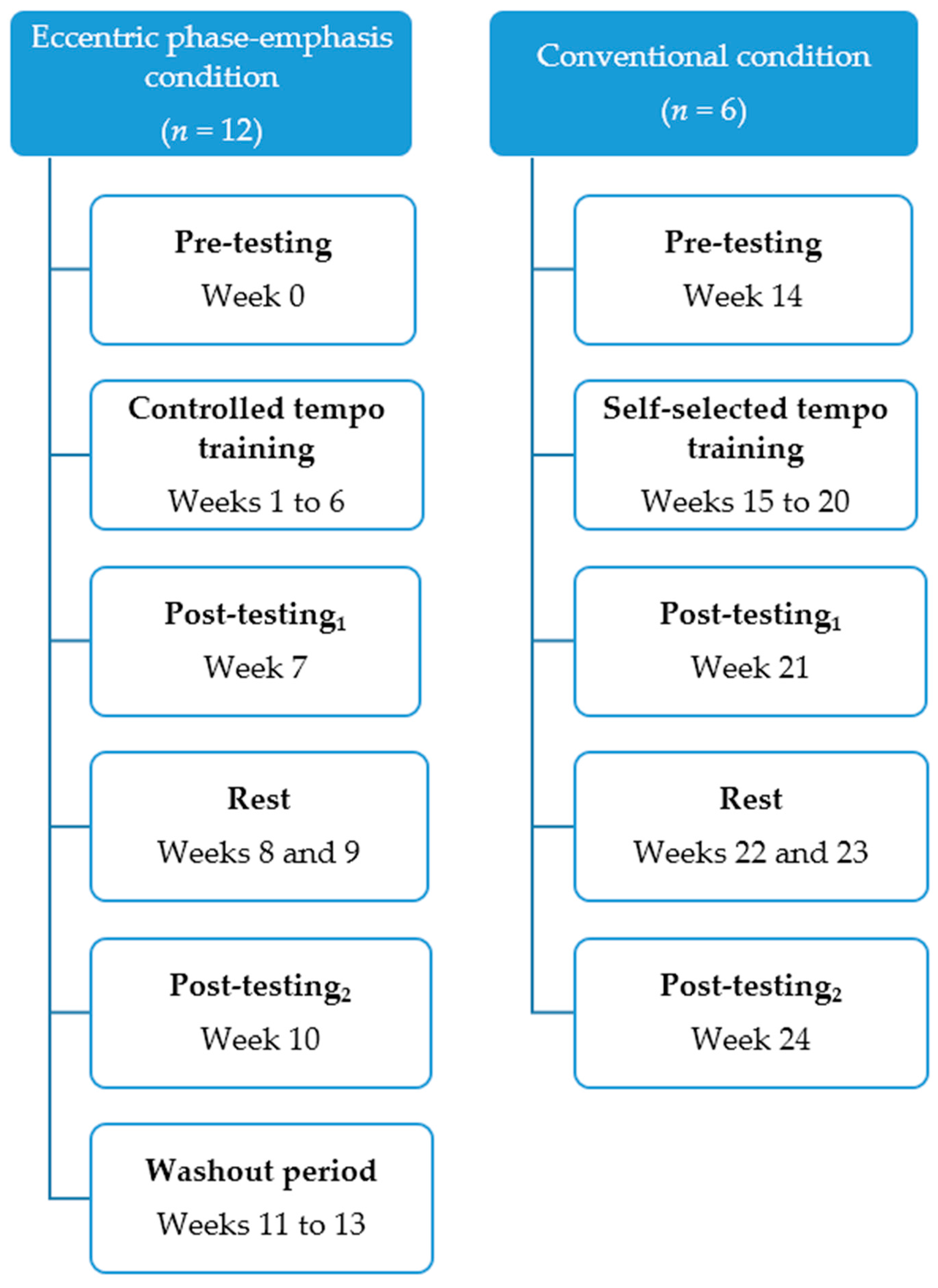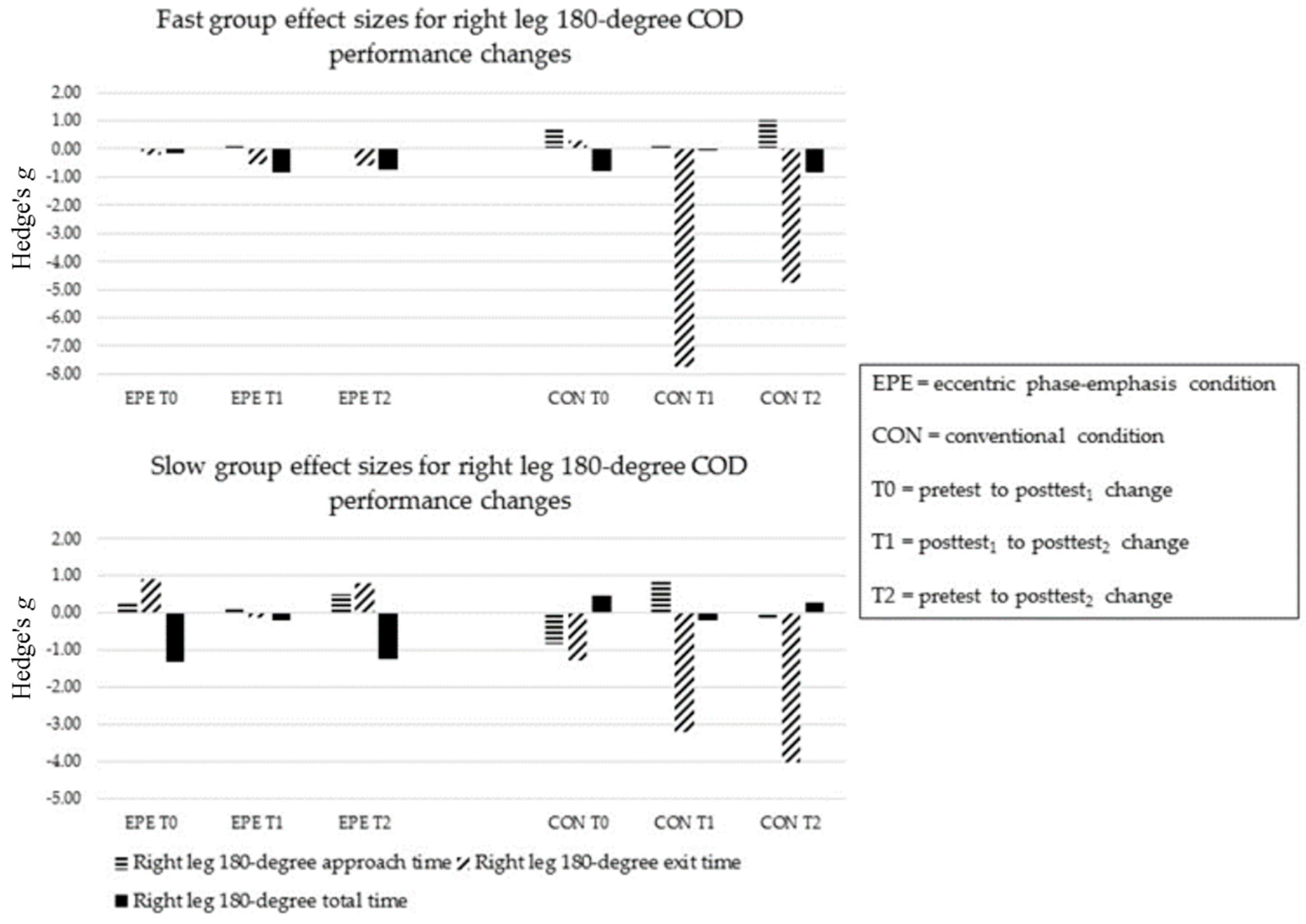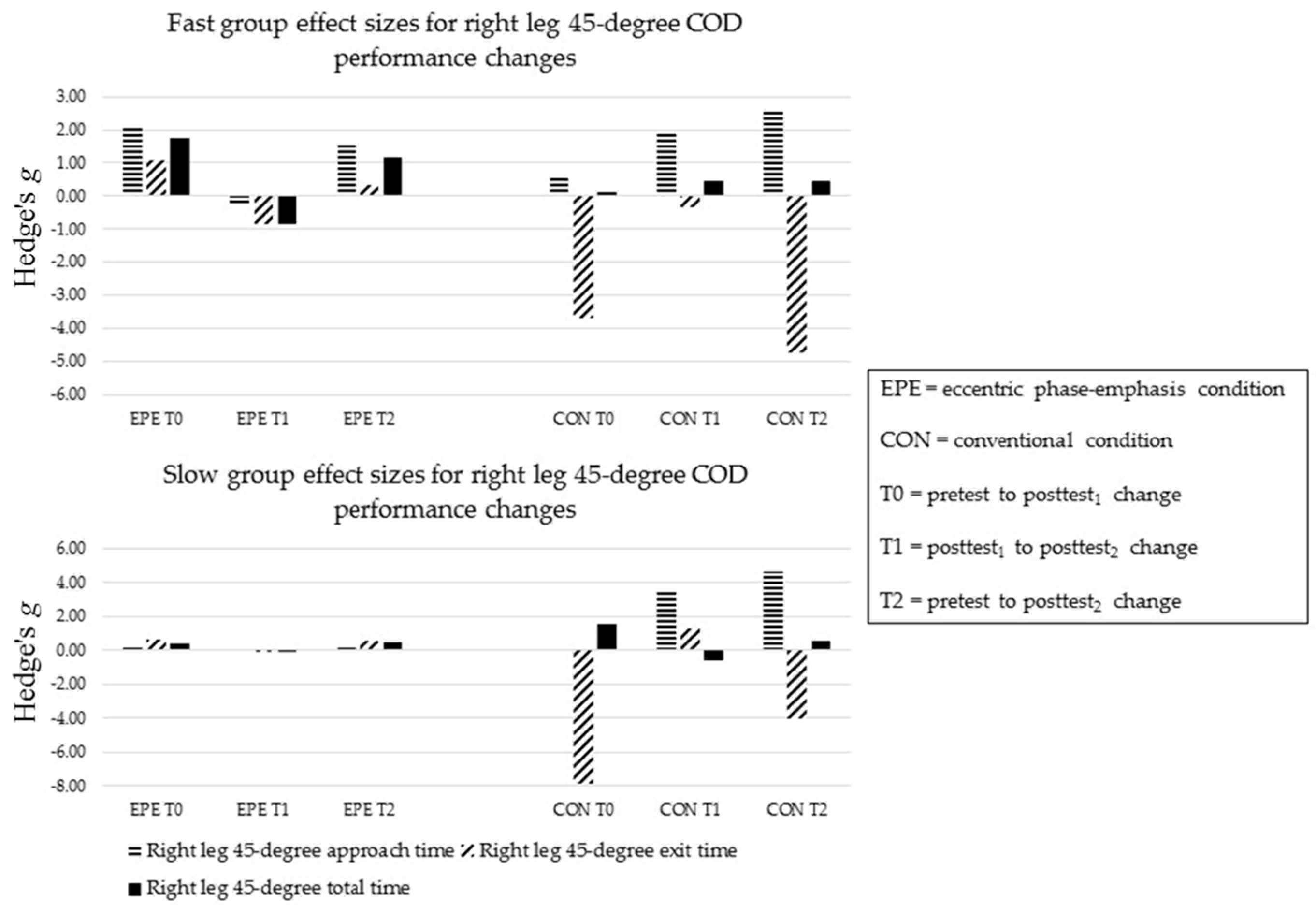Effects of a Six-Week Strength Training Programme on Change of Direction Performance in Youth Team Sport Athletes
Abstract
:1. Introduction
2. Materials and Methods
2.1. Subjects
2.2. Procedures
2.3. Anthropometry Data
2.4. Change of Direction Assessment
2.5. Strength Assessment
2.6. Training Protocol
2.7. Statistical Analysis
3. Results
3.1. Maturation during the Study
3.2. Observed Differences between Eccentric Phase-Emphasis and Conventional Training
3.2.1. Time under Eccentric Tension Differences
3.2.2. Training Volume Changes
3.2.3. Session Rating of Perceived Exertion Changes
3.2.4. Changes in Other Training Volume
3.3. Training Responses
3.3.1. Relative Peak Isometric Force Production Changes
3.3.2. Change of Direction Performance
COD Performance at 180-Degrees
COD Performance at 45-Degrees
4. Discussion
5. Conclusions
Acknowledgments
Author Contributions
Conflicts of Interest
References
- Baker, D. Differences in strength and power among junior-high, senior-high, college-aged, and elite professional rugby league players. J. Strength Cond. Res. 2002, 16, 581–585. [Google Scholar] [PubMed]
- Haff, G.G.; Nimphius, S. Training principles for power. Strength Cond. J. 2012, 34, 2–12. [Google Scholar] [CrossRef]
- Nimphius, S.; McGuigan, M.R.; Newton, R.U. Relationship between strength, power, speed, and change of direction performance of female softball players. J. Strength Cond. Res. 2010, 24, 885–895. [Google Scholar] [CrossRef] [PubMed]
- Speirs, D.K.; Bennet, M.A.; Finn, C.V.; Turner, A.P. Unilateral vs. bilateral squat training for strength, sprints, and agility in academy rugby players. J. Strength Cond. Res. 2016, 30, 386–392. [Google Scholar] [CrossRef] [PubMed]
- Suchomel, T.J.; Nimphius, S.; Stone, M.H. The importance of muscular strength in athletic performance. Sports Med. 2016, 46, 1419–1449. [Google Scholar] [CrossRef] [PubMed]
- Gamble, P. Training for Sports Speed and Agility: An Evidence-Based Approach; Routledge: Abingdon, UK, 2012; pp. 12–13, 52–53, 146–154. [Google Scholar]
- Barnes, J.L.; Schilling, B.K.; Falvo, M.J.; Weiss, L.W.; Creasy, A.K.; Fry, A.C. Relationship of jumping and agility performance in female volleyball athletes. J. Strength Cond. Res. 2007, 21, 1192–1196. [Google Scholar] [PubMed]
- Schot, P.; Dart, J.; Schuh, M. Biomechanical analysis of two change-of-direction maneuvers while running. J. Orthop. Sports Phys. Ther. 1995, 22, 254–258. [Google Scholar] [CrossRef]
- Spiteri, T.; Cochane, J.L.; Hart, N.H.; Haff, G.G.; Nimphius, S. Effect of strength on plant foot kinetics and kinematics during a change of direction task. Eur. J. Sports Sci. 2013, 13, 646–652. [Google Scholar] [CrossRef] [PubMed]
- Spiteri, T.; Newton, R.U.; Binetti, M.; Hart, N.H.; Sheppard, J.M.; Nimphius, S. Mechanical determinants of faster change of direction and agility performance in female basketball athletes. J. Strength Cond. Res. 2015, 29, 2205–2214. [Google Scholar] [CrossRef] [PubMed]
- Suzuki, Y.; Ae, M.; Takenaka, S.; Fujii, N. Comparison of support leg kinetics between side-step and cross-step cutting techniques. Sports Biomech. 2014, 13, 144–153. [Google Scholar] [CrossRef] [PubMed]
- Baker, D.G.; Newton, R.U. Comparison of lower body strength, power, acceleration, speed, agility, and sprint momentum to describe and compare playing rank among professional rugby league players. J. Strength Cond. Res. 2008, 22, 153–158. [Google Scholar] [CrossRef] [PubMed]
- Comfort, P.; Haigh, A.; Matthews, M.J. Are changes in maximal squat strength during preseason training reflected in changes in sprint performance in rugby league players? J. Strength Cond. Res. 2012, 26, 772–776. [Google Scholar] [CrossRef] [PubMed]
- Gabbett, T.J.; Seibold, A.J. Relationship between tests of physical qualities, team selection, and physical match performance in semiprofessional rugby league players. J. Strength Cond. Res. 2013, 27, 3259–3265. [Google Scholar] [CrossRef] [PubMed]
- Jones, P.A.; Thomas, C.; Dos’Santos, T.; McMahon, J.J.; Graham-Smith, P. The role of eccentric strength in 180° turns in female soccer players. Sports 2017, 5, 42–53. [Google Scholar] [CrossRef]
- Spiteri, T.; Nimphius, S.; Hart, N.H.; Specos, C.; Sheppard, J.M.; Newton, R.U. Contribution of strength characteristics to change of direction and agility performance in female basketball athletes. J. Strength Cond. Res. 2014, 28, 2415–2423. [Google Scholar] [CrossRef] [PubMed]
- Watts, D. A brief review on the role of maximal strength in change of direction speed. J. Aust. Strength Cond. 2015, 23, 100–108. [Google Scholar]
- De Hoyo, M.; de la Torre, A.; Pradas, F.; Sañudo, B.; Carrasco, L.; Mateo-Cortes, J.; Domínguez-Cobo, S.; Fernandes, O.; Gonzalo-Skok, O. Effects of eccentric overload bout on change of direction and performance in soccer players. Int. J. Sports Med. 2015, 36, 308–314. [Google Scholar] [CrossRef] [PubMed]
- De Hoyo, M.; Pozzo, M.; Sañudo, B.; Carrasco, L.; Gonzalo-Skok, O.; Domínguez-Cobo, S.; Morán-Camacho, E. Effects of 10-week eccentric overload training on kinetic parameters during change of direction in football players. Int. J. Sports Physiol. Perform. 2015, 10, 46–52. [Google Scholar] [CrossRef] [PubMed]
- Keiner, M.; Sander, A.; Wirth, K.; Schmidtbleicher, D. Long-term strength training effects on change-of-direction sprint performance. J. Strength Cond. Res. 2014, 28, 223–231. [Google Scholar] [CrossRef] [PubMed]
- Markovic, G. Poor relationship between strength and power qualities and agility performance. J. Sports Med. Phys. Fit. 2007, 47, 276–283. [Google Scholar]
- Chaouachi, A.; Brughelli, M.; Chamari, K.; Levin, G.T.; Ben Abdelkrim, N.; Laurencelle, L.; Castagna, C. Lower limb maximal dynamic strength and agility determinants in elite basketball players. J. Strength Cond. Res. 2009, 23, 1570–1577. [Google Scholar] [CrossRef] [PubMed]
- Hojka, V.; Stastny, P.; Rehak, T.; Golas, A.; Mostowik, A.; Zawart, M.; Musálek, M. A systematic review of the main factors that determine agility in sport using structural equation modeling. J. Hum. Kinet. 2016, 52, 115–123. [Google Scholar] [CrossRef] [PubMed]
- Sherar, L.B.; Mirwald, R.L.; Baxter-Jones, A.D.G.; Thomis, M. Prediction of adult height using maturity-based cumulative height velocity curves. J. Pediatr. 2005, 147, 508–514. [Google Scholar] [CrossRef] [PubMed]
- Gabbett, T.J. Physiological and anthropometric correlates of tackling ability in rugby league players. J. Strength Cond. Res. 2009, 23, 540–548. [Google Scholar] [CrossRef] [PubMed]
- McGuigan, M.R.; Winchester, J.B. The relationship between isometric and dynamic strength in college football players. J. Sports Sci. Med. 2008, 7, 101–105. [Google Scholar] [PubMed]
- Comfort, P.; Jones, P.A.; McMahon, J.J.; Newton, R. Effect of knee and trunk angle on kinetic variables during the isometric midthigh pull; test-retest reliability. Int. J. Sports Physiol. Perform. 2015, 10, 58–63. [Google Scholar] [CrossRef] [PubMed]
- Wernbom, M.; Augustsson, J.; Thomeé, R. The influence of frequency, intensity, volume and mode of strength training on whole muscle cross-sectional area in humans. Sports Med. 2007, 37, 225–264. [Google Scholar] [CrossRef] [PubMed]
- McGuigan, M.R.; Foster, C. A new approach to monitor resistance training. Strength Cond. J. 2004, 26, 42–47. [Google Scholar] [CrossRef]
- Singh, F.; Foster, C.; Tod, D.; McGuigan, M.R. Monitoing different types of resistance training using session rating of perceived exertion. Int. J. Sports Physiol. Perform. 2007, 2, 34–45. [Google Scholar] [CrossRef] [PubMed]
- Hopkins, W.B. Measures of reliability in sports medicine and science. Sports Med. 2000, 30, 1–15. [Google Scholar] [CrossRef] [PubMed]
- Hewit, J.K.; Cronin, J.B.; Hume, P.A. Kinematic factors affecting fast and slow straight and change-of-direction acceleration times. J. Strength Cond. Res. 2013, 27, 69–75. [Google Scholar] [CrossRef] [PubMed]
- Ialongo, C. Understanding the effect size and its measures. Biochem. Med. 2016, 26, 150–163. [Google Scholar] [CrossRef] [PubMed]
- Hopkins, W.G.; Marshall, S.W.; Batterham, A.M.; Hanin, J. Progressive statistics for studies in sports medicine and exercise science. Med. Sci. Sports Exerc. 2009, 41, 3–12. [Google Scholar] [CrossRef] [PubMed]
- Douglas, J.; Pearson, S.; Ross, A.; McGuigan, M. Eccentric exercise: Physiological characteristics and acute responses. Sports Med. 2017, 47, 663–675. [Google Scholar] [CrossRef] [PubMed]
- Hortobágyi, T.; Barrier, J.; Beard, D.; Braspennincx, J.; Koens, P.; Dempsey, L.; Lambert, J. Greater initial adaptations to submaximal muscle lengthening than maximal shortening. J. Appl. Phyisol. 1996, 81, 1677–1682. [Google Scholar]
- Isner-Horobeti, M.; Dufour, S.P.; Vautravers, P.; Geny, B.; Coudeyre, E.; Richard, R. Eccentric exercise training: Modalities, applications and perspectives. Sports Med. 2013, 43, 483–512. [Google Scholar] [CrossRef] [PubMed]
- Kubo, K.; Ikebukuro, T.; Yata, H.; Tsunoda, N.; Kanehisa, H. Time course of changes in muscle and tendon properties during strength training and detraining. J. Strength Cond. Res. 2010, 24, 322–331. [Google Scholar] [CrossRef] [PubMed]
- Ogasawara, R.; Yasuda, T.; Ishii, N.; Abe, T. Comparison of muscle hypertrophy following 6-months of continuous and periodic strength training. Eur. J. Appl. Physiol. 2012, 113, 975–985. [Google Scholar] [CrossRef] [PubMed]
- Secomb, J.L.; Nimphius, S.; Farley, O.R.L.; Lundgren, L.; Tran, T.T.; Parsonage, J.; Sheppard, J.M. Three weeks cessation from strength training in adolescent athletes increases lower-body isometric strength. J. Aust. Strength Cond. 2015, 23, 26–29. [Google Scholar]
- Saxton, J.M.; Donnelly, A.E. Length-specific impairment of skeletal muscle contractile function after eccentric muscle actions in man. Clin. Sci. 1996, 90, 119–125. [Google Scholar] [CrossRef] [PubMed]
- Brughelli, M.; Cronin, J.; Levin, G.; Chaouachi, A. Understanding change of direction ability in sport: A review of resistance training studies. J. Sports Med. 2008, 38, 1045–1063. [Google Scholar] [CrossRef] [PubMed]
- Sheppard, J.M.; Dawes, J.J.; Jeffreys, I.; Spiteri, T.; Nimphius, S. Broadening the view of agility: A scientific review of the literature. J. Aust. Strength Cond. 2014, 22, 6–25. [Google Scholar]
- Gabbett, T.J.; Kelly, J.N.; Sheppard, J.M. Speed, change of direction speed, and reactive agility of rugby league players. J. Strength Cond. Res. 2008, 22, 174–181. [Google Scholar] [CrossRef] [PubMed]
- Claudino, J.G.; Cronin, J.B.; Mezêncio, B.; Pinho, J.P.; Pereira, C.; Mochizuki, L.; Amadio, A.C.; Serrão, J.C. Autoregulating jump performance to induce functional overreaching. J. Strength Cond. Res. 2016, 30, 2242–2249. [Google Scholar] [CrossRef] [PubMed]
- Claudino, J.G.; Mezêncio, B.; Soncin, R.; Valadão, P.F.; Takao, P.P.; Bianco, R.; Roschel, H.; Amadio, A.C.; Serrão, J.C. Development of an individualized familiarization method for vertical jumps. Rev. Bras. Med. Esporte 2013, 19, 359–362. [Google Scholar] [CrossRef]
- Qiao, M.; Brown, B.; Jindrich, D.L. Compensations for increased rotational inertia during human cutting turns. J. Exp. Biol. 2014, 217, 432–443. [Google Scholar] [CrossRef] [PubMed]







| Targeted Body Region | Main Exercises | Auxiliary Exercises |
| Lower body exercises | Parallel back squat | Front squat |
| Hexagon-bar squat | Front-racked backward lunge | |
| Rear elevated split squat | ||
| Kettlebell lateral lunge | ||
| Stiff-legged deadlift | ||
| Upper body exercises | Flat bench press | Dumbbell incline bench press |
| Standing overhead press | Barbell pullover | |
| Unilateral dumbbell bench press | ||
| Barbell inverted row | ||
| Bent-over row | ||
| Barbell upright row | ||
| Prone kettlebell rows | ||
| Dumbbell shoulder complex | ||
| Main exercises | Sets | Repetitions |
| Week 1 | 3 | 8, 10 |
| Week 2 | - | - |
| Week 3 | - | 6 |
| Week 4 | - | 8, 10 |
| Week 5 | - | - |
| Week 6 | - | 6, 8 |
| Assistant exercises | Sets | Repetitions |
| Week 1 | 3 | 5–8 |
| Week 2 | - | - |
| Week 3 | - | 6, 8 |
| Week 4 | - | 6, 8, 10 |
| Week 5 | - | - |
| Week 6 | - | 4, 5, 8, 10 |
| Performance Measures | Left Leg | |||||
| Pre-test | Post-test1 | Post-test2 | ||||
| Fast | Slow | Fast | Slow | Fast | Slow | |
| Isometric peak force (N/N) | 1.67 ± 0.18 | 1.69 ± 0.30 | 1.68 ± 0.32 | 1.61 ± 0.20 | 2.00 ± 0.28 | 1.89 ± 0.26 |
| 180-degree approach time (s) | 1.08 ± 0.06 | 1.12 ± 0.07 | 1.08 ± 0.03 | 1.12 ± 0.02 | 1.09 ± 0.04 | 1.13 ± 0.07 |
| 180-degree exit time (s) | 1.08 ± 0.12 | 1.06 ± 0.07 | 1.12 ± 0.08 | 1.09 ± 0.07 | 1.07 ± 0.04 | 1.13 ± 0.06 |
| 180-degree total time (s) | 3.00 ± 0.17 | 3.16 ± 0.17 | 2.95 ± 0.12 | 3.10 ± 0.13 | 2.92 ± 0.05 | 2.95 ± 0.19 |
| 45-degree approach time (s) | 0.95 ± 0.04 | 0.98 ± 0.03 | 0.95 ± 0.06 | 1.03 ± 0.04 | 0.98 ± 0.06 | 1.00 ± 0.04 |
| 45-degree exit time (s) | 0.66 ± 0.06 | 0.74 ± 0.02 | 0.72 ± 0.08 | 0.77 ± 0.03 | 0.66 ± 0.05 | 0.74 ± 0.03 |
| 45-degree total time (s) | 1.61 ± 0.08 | 1.72 ± 0.01 | 1.67 ± 0.12 | 1.80 ± 0.04 | 1.64 ± 0.09 | 1.74 ± 0.06 |
| Performance Measures | Right Leg | |||||
| Pre-test | Post-test1 | Post-test2 | ||||
| Fast | Slow | Fast | Slow | Fast | Slow | |
| Isometric peak force (N/N) | 1.72 ± 0.18 | 1.79 ± 0.30 | 1.85 ± 0.29 | 1.67 ± 0.24 | 2.14 ± 0.25 | 2.13 ± 0.32 |
| 180-degree approach time (s) | 1.09 ± 0.08 | 1.09 ± 0.02 | 1.08 ± 0.04 | 1.10 ± 0.04 | 1.09 ± 0.06 | 1.11 ± 0.02 |
| 180-degree exit time (s) | 1.14 ± 0.14 | 1.04 ± 0.06 | 1.11 ± 0.08 | 1.11 ± 0.08 | 1.07 ± 0.04 | 1.10 ± 0.08 |
| 180-degree total time (s) | 3.00 ± 0.18 | 3.16 ± 0.12 | 2.98 ± 0.08 | 3.01 ± 0.10 | 2.90 ± 0.08 | 2.99 ± 0.17 |
| 45-degree approach time (s) | 0.91 ± 0.03 | 0.99 ± 0.03 | 0.96 ± 0.02 | 1.00 ± 0.06 | 0.95 ± 0.01 | 1.00 ± 0.04 |
| 45-degree exit time (s) | 0.63 ± 0.03 | 0.70 ± 0.04 | 0.69 ± 0.06 | 0.73 ± 0.05 | 0.64 ± 0.02 | 0.73 ± 0.05 |
| 45-degree total time (s) | 1.54 ± 0.04 | 1.70 ± 0.07 | 1.65 ± 0.07 | 1.74 ± 0.11 | 1.60 ± 0.01 | 1.73 ± 0.09 |
| Performance Measures | Left Leg | |||||
| Pre-test | Post-test1 | Post-test2 | ||||
| Fast | Slow | Fast | Slow | Fast | Slow | |
| Isometric peak force (N/N) | 1.59 ± 0.09 | 1.81 ± 0.26 | 1.99 ± 0.24 | 1.71 ± 0.13 | 1.63 ± 0.20 | 1.83 ± 0.43 |
| 180-degree approach time (s) | 1.17 ± 0.07 | 1.16 ± 0.06 | 1.13 ± 0.02 | 1.13 ± 0.07 | 1.11 ± 0.03 | 1.10 ± 0.03 |
| 180-degree exit time (s) | 1.07 ± 0.04 | 1.12 ± 0.10 | 1.09 ± 0.10 | 1.05 ± 0.06 | 1.12 ± 0.09 | 1.05 ± 0.06 |
| 180-degree total time (s) | 2.94 ± 0.11 | 2.94 ± 0.16 | 3.00 ± 0.12 | 3.02 ± 0.19 | 2.95 ± 0.11 | 2.98 ± 0.19 |
| 45-degree approach time (s) | 1.00 ± 0.02 | 1.00 ± 0.06 | 0.98 ± 0.03 | 0.99 ± 0.03 | 0.97 ± 0.05 | 1.10 ± 0.08 |
| 45-degree exit time (s) | 0.77 ± 0.03 | 0.76 ± 0.11 | 0.79 ± 0.13 | 0.72 ± 0.07 | 0.73 ± 0.06 | 0.75 ± 0.17 |
| 45-degree total time (s) | 1.69 ± 0.06 | 1.83 ± 0.10 | 1.65 ± 0.03 | 1.83 ± 0.06 | 1.62 ± 0.03 | 1.85 ± 0.17 |
| Performance Measures | Right Leg | |||||
| Pre-test | Post-test1 | Post-test2 | ||||
| Fast | Slow | Fast | Slow | Fast | Slow | |
| Isometric peak force (N/N) | 1.66 ± 0.24 | 1.50 ± 0.06 | 2.08 ± 0.36 | 1.95 ± 0.30 | 1.77 ± 0.34 | 1.78 ± 0.03 |
| 180-degree approach time (s) | 1.09 ± 0.02 | 1.13 ± 0.04 | 1.12 ± 0.07 | 1.07 ± 0.07 | 1.13 ± 0.05 | 1.12 ± 0.02 |
| 180-degree exit time (s) | 1.07 ± 0.07 | 1.14 ± 0.07 | 1.09 ± 0.04 | 1.04 ± 0.02 | 0.75 ± 0.03 | 0.74 ± 0.12 |
| 180-degree total time (s) | 3.03 ± 0.15 | 2.90 ± 0.16 | 2.94 ± 0.06 | 2.98 ± 0.23 | 2.94 ± 0.04 | 2.94 ± 0.19 |
| 45-degree approach time (s) | 0.99 ± 0.06 | 0.96 ± 0.03 | 1.02 ± 0.06 | 0.97 ± 0.06 | 1.13 ± 0.05 | 1.12 ± 0.02 |
| 45-degree exit time (s) | 1.07 ± 0.07 | 1.14 ± 0.07 | 0.77 ± 0.05 | 0.65 ± 0.04 | 0.75 ± 0.03 | 0.74 ± 0.12 |
| 45-degree total time (s) | 1.65 ± 0.13 | 1.71 ± 0.06 | 1.66 ± 0.09 | 1.82 ± 0.09 | 1.71 ± 0.14 | 1.76 ± 0.12 |
© 2017 by the authors. Licensee MDPI, Basel, Switzerland. This article is an open access article distributed under the terms and conditions of the Creative Commons Attribution (CC BY) license (http://creativecommons.org/licenses/by/4.0/).
Share and Cite
Bourgeois, F.A.; Gamble, P.; Gill, N.D.; McGuigan, M.R. Effects of a Six-Week Strength Training Programme on Change of Direction Performance in Youth Team Sport Athletes. Sports 2017, 5, 83. https://doi.org/10.3390/sports5040083
Bourgeois FA, Gamble P, Gill ND, McGuigan MR. Effects of a Six-Week Strength Training Programme on Change of Direction Performance in Youth Team Sport Athletes. Sports. 2017; 5(4):83. https://doi.org/10.3390/sports5040083
Chicago/Turabian StyleBourgeois, Frank A., Paul Gamble, Nic D. Gill, and Mike R. McGuigan. 2017. "Effects of a Six-Week Strength Training Programme on Change of Direction Performance in Youth Team Sport Athletes" Sports 5, no. 4: 83. https://doi.org/10.3390/sports5040083
APA StyleBourgeois, F. A., Gamble, P., Gill, N. D., & McGuigan, M. R. (2017). Effects of a Six-Week Strength Training Programme on Change of Direction Performance in Youth Team Sport Athletes. Sports, 5(4), 83. https://doi.org/10.3390/sports5040083





